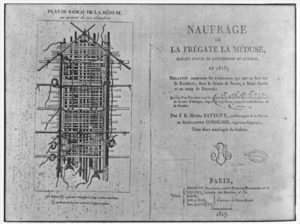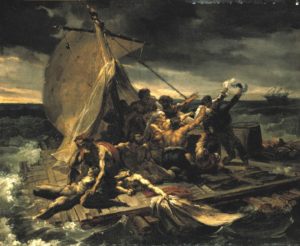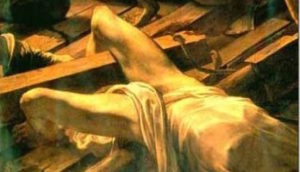by Elizabeth C. Goldsmith (Regular Contributor)
Two hundred years ago, in July 1816, a French Navy frigate named La Méduse was wrecked off the coast of Mauritania. On board were passengers headed for Africa for an array of reasons –soldiers in the colonial army on a mission to reconquer Senegal, settlers, scientists, adventurers. Its captain was an inexperienced naval officer who had been appointed to the post as a political favor. His poor judgment resulted in the ship’s foundering on a sandbar.
 It was the age of shipwrecks. But this one became notorious almost immediately. It was a political scandal for the newly restored French monarchy because of the inexperienced captain and his crew. Survivors recounted chaos on board, undisciplined evacuation, sailors boarding the lifeboats and leaving passengers behind. But the worst part of the story was the tale of the hastily built wooden raft that was put into the water with 146 men and one woman on board, It was initially towed by one of the smaller boats, but then cut adrift when the job became too difficult for the oarsmen. On the raft, there followed savage episodes of mutiny, murder, and cannibalism. After two weeks, what remained of the raft was plucked out of the water by a passing ship. There were 15 survivors on board.
It was the age of shipwrecks. But this one became notorious almost immediately. It was a political scandal for the newly restored French monarchy because of the inexperienced captain and his crew. Survivors recounted chaos on board, undisciplined evacuation, sailors boarding the lifeboats and leaving passengers behind. But the worst part of the story was the tale of the hastily built wooden raft that was put into the water with 146 men and one woman on board, It was initially towed by one of the smaller boats, but then cut adrift when the job became too difficult for the oarsmen. On the raft, there followed savage episodes of mutiny, murder, and cannibalism. After two weeks, what remained of the raft was plucked out of the water by a passing ship. There were 15 survivors on board.
For the French, the events of the Medusa shipwreck became emblematic of a disintegration of the values of discipline, honor, and simple humanity in a culture already crushed by the Napoleonic wars. The painter Théodore Géricault produced an enormous painting of the raft. To those who viewed it as it was shown in Paris and London, the monumental work seemed to symbolize a battered humanity, reaching desperately for a distant hope represented by the tiny ship on the horizon.
 Géricault was not interested in producing a realistic representation of the disaster, but he was obsessed by the event and the published narrative that had been written by two survivors, Alexandre Corréard and Henri Savigny. He closed himself up in his studio for months and made numerous studies of human bodies thrown together, using live models but also cadavers and body parts that he acquired from the morgue. He interviewed Corréard and Savigny. The resulting painting had a huge impact and was immediately controversial. Some considered it almost treasonously humiliating as a representation of the French.
Géricault was not interested in producing a realistic representation of the disaster, but he was obsessed by the event and the published narrative that had been written by two survivors, Alexandre Corréard and Henri Savigny. He closed himself up in his studio for months and made numerous studies of human bodies thrown together, using live models but also cadavers and body parts that he acquired from the morgue. He interviewed Corréard and Savigny. The resulting painting had a huge impact and was immediately controversial. Some considered it almost treasonously humiliating as a representation of the French.
Every one of the passengers who had the misfortune of being put on the raft had a story. But the one story that may have been the most painful emblem of the breakdown of French civilization was one that remained anonymous. It was the story of the lone woman on the raft. Her history, if not her name, had been told by Corréard and Savigny, but somehow it remained an unspoken detail in the public discussions of the disaster. A detail perhaps almost too horrible to be repeated. To this day, it is a detail that has been forgotten.
She was not to be one of the survivors. But she fought for her life. She was traveling with her husband, and had served 20 years with the French armies as a ‘cantinière’, a woman who carried supplies and prepared food for the soldiers. We can assume she  was physically strong. She was reported to have argued for her own survival on the basis of her strength and potential usefulness in support of her fellow passengers. But she was thrown off the raft along with others deemed too weak to last – not once, not twice, but three times over a 12-day period. The last time, she had fractured her leg when it was caught between two boards.
was physically strong. She was reported to have argued for her own survival on the basis of her strength and potential usefulness in support of her fellow passengers. But she was thrown off the raft along with others deemed too weak to last – not once, not twice, but three times over a 12-day period. The last time, she had fractured her leg when it was caught between two boards.
We know that Géricault thought about depicting a female figure on his raft, if only, possibly, a dead one. He included studies of female bodies in his preliminary sketches. And he knew the story, having read and interviewed Corréard and Savigny. To me, one of his preliminary versions of the painting is very suggestive of the story of the doomed cantinière and her husband. It shows a man collapsed in the center of the raft grasping a long piece of fabric that trails off into the water.
 In the final version of the painting, this fabric has become a transparent covering of a body whose head is below the surface of the water, hidden from view. Could this body be female? It looks muscular, but also somehow feminine – at least one art critic (Michael Glover) has commented that he thinks it is a woman. The body is trapped, half on, half off the raft – by one leg , caught between two boards.
In the final version of the painting, this fabric has become a transparent covering of a body whose head is below the surface of the water, hidden from view. Could this body be female? It looks muscular, but also somehow feminine – at least one art critic (Michael Glover) has commented that he thinks it is a woman. The body is trapped, half on, half off the raft – by one leg , caught between two boards.
Look closely. What do you think? Did Géricault want to suggest the story of the unfortunate cantinière?
